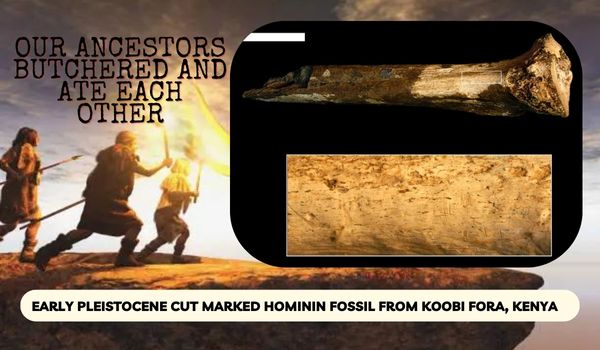A new study has revealed that ancient humans used to butcher each other and eat their flesh. A fossilized leg bone bearing cut marks made by stone tools found and is believed to be the earliest evidence.
In the development of human evolution, every discovery holds the potential to rewrite our understanding of our ancient ancestors.
Recently, researchers stumbled upon a fossilized leg bone that has shed light on a dark and intriguing aspect of our past: the use of stone tools for butchering and, possibly, cannibalism among our early human relatives.
This remarkable find, boasting nine unmistakable cut marks, unveils a slice of our history that was previously obscured. Join us as we delve into this captivating discovery and its implications for our understanding of early hominins.
A Glimpse into the Past
Located in the heart of Nairobi, Kenya, this groundbreaking discovery centers around a 1.45-million-year-old hominin shin bone found within the confines of a local museum.
The fossilized leg bone, once belonging to one of our ancient kin, reveals a story that has remained hidden for millennia.
Also Read: What is the importance of ancient metal cauldrons in human history?
At the helm of this extraordinary revelation is lead author Briana Pobiner, a paleoanthropologist whose expertise revolves around the evolution of our diet, particularly our consumption of meat and, in this case, the possibility of cannibalism among hominins.
Unearthing the Evidence
The highlight of this discovery is undoubtedly the nine well-defined cut marks etched onto the fossilized leg bone. These marks, carefully studied through advanced 3D scans by co-author Michael Pante from Colorado State University, were determined to be the result of stone tool usage.
Placed strategically where the calf muscle once attached to the bone, these consistent markings strongly suggest the involvement of Stone Age butchers in the processing of this ancient leg.
A Nutritional Pursuit
While the idea of cannibalism may immediately spring to mind, researchers lean towards a more pragmatic explanation. The butchery marks on this hominin shin bone seem to be driven by nutritional needs rather than ritualistic or ceremonial practices.
This interpretation gains credence from the presence of similar cut marks on fossilized animal bones discovered in the same region. The intention appears to have been the consumption of meat for sustenance rather than any gruesome rituals.
Cannibalism or Coexistence?
It's essential to note that this discovery raises questions as much as it answers them. While the evidence points to the butchery of early hominins, scientists are cautious in definitively concluding that this represents cannibalism.
One factor complicating the interpretation is the coexistence of multiple hominin species in the region. Additionally, uncertainties persist regarding the timing of the big cat bite marks found on the same shin bone, further clouding the cannibalism hypothesis.
A Step Back in Time
This study, recently published in the nature.com journal Scientific Reports, is just another piece in the intricate puzzle of our evolutionary history. Evidence of cannibalism is not entirely rare in the fossils of humans and their relatives, dating back nearly 2.9 million years.
It serves as a reminder that our ancient ancestors lived in a world vastly different from our own, one where survival was often a brutal and unrelenting struggle.
Rediscovering Our Past
Beyond its implications for our understanding of ancient dietary practices, this discovery underscores the significance of revisiting museum collections for new research opportunities. Often, the answers to age-old questions about our origins lie hidden in plain sight, waiting for keen-eyed researchers to unlock their secrets.
The fossilized leg bone, with its enigmatic cut marks, is a testament to the enduring curiosity of scientists and the ever-evolving nature of our understanding of human history.
Conclusion
In the corridors of history, the discovery of nine distinct cut marks on a fossilized hominin shin bone serves as a beacon illuminating a chapter of our past that has long remained shrouded in mystery.
While it tantalizingly hints at the possibility of cannibalism among our early human relatives, it also urges us to approach such findings with caution, considering the complexities of the ancient world.
This revelation reminds us that our journey as a species is an ever-unfolding narrative, with countless stories still waiting to be unearthed from the sands of time.
Published: 26 June 2023
Research report: https://doi.org/10.1038/s41598-023-35702-7






0 Comments